Khekhekhe's First Fruits ceremony

Myself and Khekhekhe
In 1999 I visited Khekhekhe with Graham, to negotiate a price for National Geographic to do a piece on him. I wrote up that encounter at the time. Khekhekhe held a ceremony on the 23rd of Feb every year - which he called the First Fruits ceremony. It seemed really to be a time for the old Mthethwa Sangomas to get together, Khekhekhe to show his prowess with snakes, and some beasts to die for the table.
My first visit to the ceremony I counted six cowhides stretched over various roofs - meat for the party.
The old man died about 18 months ago. Graham and I had visited him that year, and he was clearly feeling his age then. Khekhekhe was an Mthethwa - a historic tribe in this area before the Zulus. In Khekhekhe’s kraal is the grave of one of his ancestors - Dingiswayo. Dingiswayo was Shaka Zulu’s Mentor - Shaka served under him and learned his battle strategies before refining them for his own empire later.
Khekhekhe is now buried next to him at the kraal.
Through their influence an success, everyone in Zululand is a Zulu - even though they might originally have been Mthethwa or Ndwandwe, so I think of Khekhekhe as a Zulu. Zulus handle succession very poorly - there has always been a scrap when the mantle is passed to the next generation.
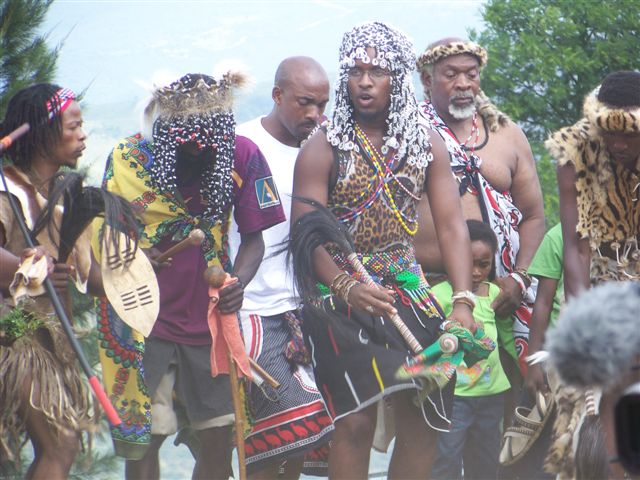
Khekhekhe’s death was no different. Rumour has it that the bank accounts were cleaned out in short order - about R2 million disappeared. In the snake house was found a suitcase with about half a million in cash. The old man’s business was all cash, and I doubt that the taxman called to look at his books. He had a bus business, undoubtably run by someone else - red buses and taxis with “Z.MTHETHWA” written on the side to discourage anyone who was thinking about stealing from the greatest Sangoma on the Tugela. The half million was distributed equitably among his wives and children. There seemed an element of mistrust now - and talking to Ngqomombo she decided to move away to the Transkei where her daughter lived.
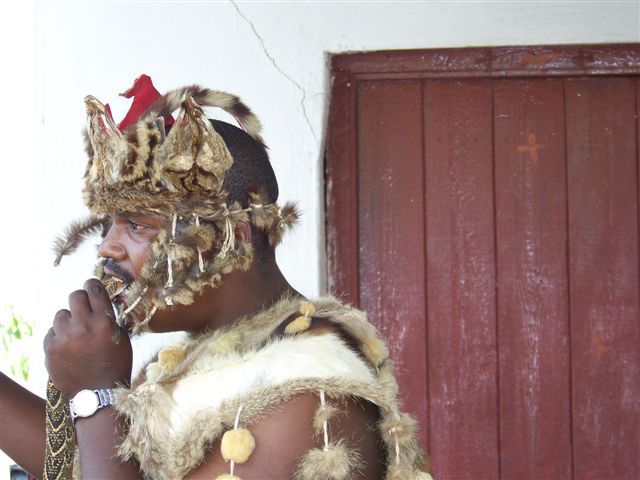
Talking to an unwilling snake
First Fruits ceremony
So, I was curious to see what has happened to the place after the old man had passed on. We went there again on 23rd Feb for the ceremony. With us were Kelsey, an American visiting South Africa to help deploy Wizzy Digital Courier, and a couple of other friends from New York City, Dave and MJ, and a friend of mine from Cape Town who is training to be a Sangoma herself. We also had a few other tourists and Zululanders along for the ride.
So - how were things organised ?
We found a camp divided - what had been one kraal was now two. The older son had the lower kraal with the graves, the water close by, and the cattle kraal. However, further up the hill was now a much larger establishment, with a new shrine to the ancestors, steps, and concrete. On this day the larger celebration was higher on the hill.
But where Khekhekhe insisted on a procession of all his contemporary Sangomas at his First Fruits, with him leading and displaying the snakes, the son was a one man show. Certainly, there were a lot of other, mostly female, sangomas in attendance, and the three metre python he had draped around his shoulders was a sight to see.
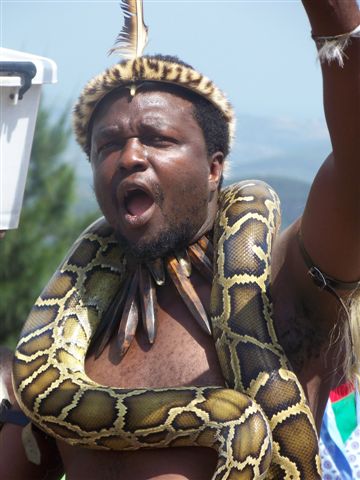
Khekhekhe’s son
Snakes
Later he brought out a bright greenmamba, and a brown boomslang, both very much more to be feared than the huge python. The boomslang even bit him - much to the son’s displeasure. I presume the snakes had been milked of their poison before the ceremony, but it was the wrong thing to happen at the ceremony. He sat down for a while after that incident. Re-examining the video footage afterwards, we think he may have killed the boomslang soon after - the snake was limp and lifeless. Tradition had it that if a snake bit Khekhekhe, the snake died. That can be arranged..
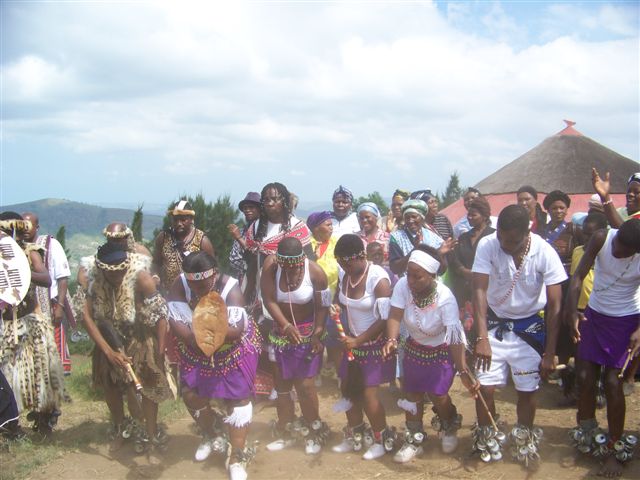
Sangomas
How does one become a Sangoma ?
A Sangoma is a Calling. Tradition has it that the ancestors call you - and give you a sign. Of course, all such signs can be ambiguous, but a common one is illness
- you become ill, and do not seem to get better, or your life is not working in other ways, only solveable by taking up the challenge of becoming a Sangoma. However, my friend Victor became ill, and took it as the Sign. He refused to go to hospital, and died. Oops. Be sensible.
There is another traditional position in Zulu society - the iNganga - the Herbalist. This is more a profession - there is also a training in the plants and their various roles, and is not to be confused with the Sangoma.
When in Eshowe, I made enquiries on behalf of someone else to find this process. We had heard it was done through the Magistrates Court. So
- we went there. I knew one of the magistrates there, whose zulu was fluent. He did not know, but said it definitely did not happen in his court. There happened to be a visiting magistrate there from Pongola - we asked him, and he promised to investigate. Meanwhile, general opinion was that we should ask in the traditional court - a parallel system run under the auspices of the Chief. I called Lily, the local chief. She gave me the number of Mr Mhlongo. I called him - he asked to speak to a zulu-speaker. It turned out he had a shop in Eshowe - Graham and I went around. A large, jolly man, he proudly pointed ou this iNganga certificate hanging on the wall. His little black phonebook revealed the number of another Mr. Mhlongo - who lives in Greytown, Natal, the signature on the certificate in question.
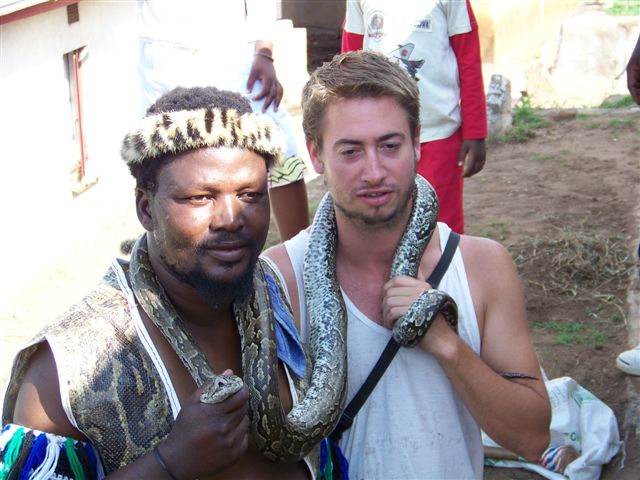
Even though Mr. Mhlongo was the examiner for the iNganga, not the Sangoma, I figured he would be familiar with the procedure in his parallel profession, and I called him. His english was good, and he carefully explained the graduation process for the iNganga, involving an initial trainee certificate, some years of training, and finally an exam. we discussed this for a bit, and then I asked if there was a similar procedure for the Sangoma.
He explained that the Sangoma was fundamentally different, as the source of their power comes from their locality- their space and their people. He said it would be too difficult and expensive to travel to examine each Sangoma at their residence. But the process mainly entailed studying under an existing Sangoma, who would reveal the local initiations, practice, and graduation. Much appears to revolve around the slaughter of an animal - a goat or a cow, at a ceremony. I took this to be a diplomatic admission that there was no official certificate or recognition of the Sangoma - it is a mysterious art that needs to earn local recognition in their own area. I thanked him very much for his clear explanation. I have his phone number if anyone is interested.
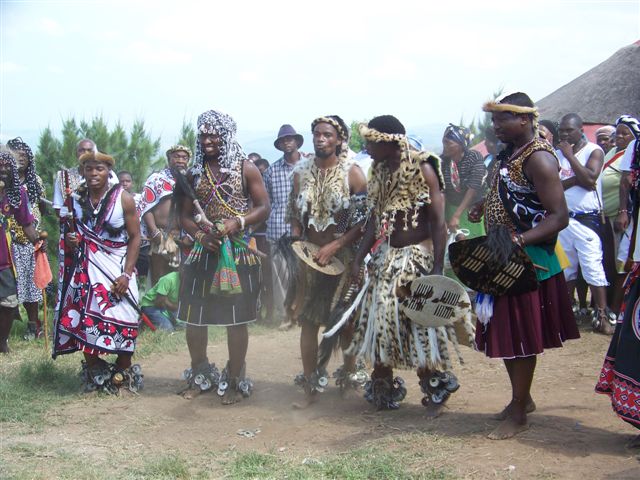
Their role in society
What role does the sangoma play in modern Zulu society ?
I think they perform a role similar to a counsellor. They are paid money to listen to your problem, often about affairs of the heart, illness, travel, or family issues. Paying money serves a purpose - the client prepares their questions, maybe the sangoma is the first one to hear this difficult problem spelled out properly. The sangoma listens carefully, and repeats back to the client what they asked, with added wisdom from the sangoma mixed in.
Khekhekhe must, like the priest at the confessional, have heard very many stories. So a new one is like an old one, but slightly different. Knowing all the variations, he can see a path through to a solution.
But would you go to one of his sons, who cannot even live easily with his brother down the hill ? You are ‘called’ to be a sangoma - it is not a profession or skill. Sometimes these things skip a generation. Or perhaps tradition says Zulus will continue to find answers by going to the kraal where Khekhekhe and Dingiswayo are buried. They are, after all, seeking help from their ancestors.